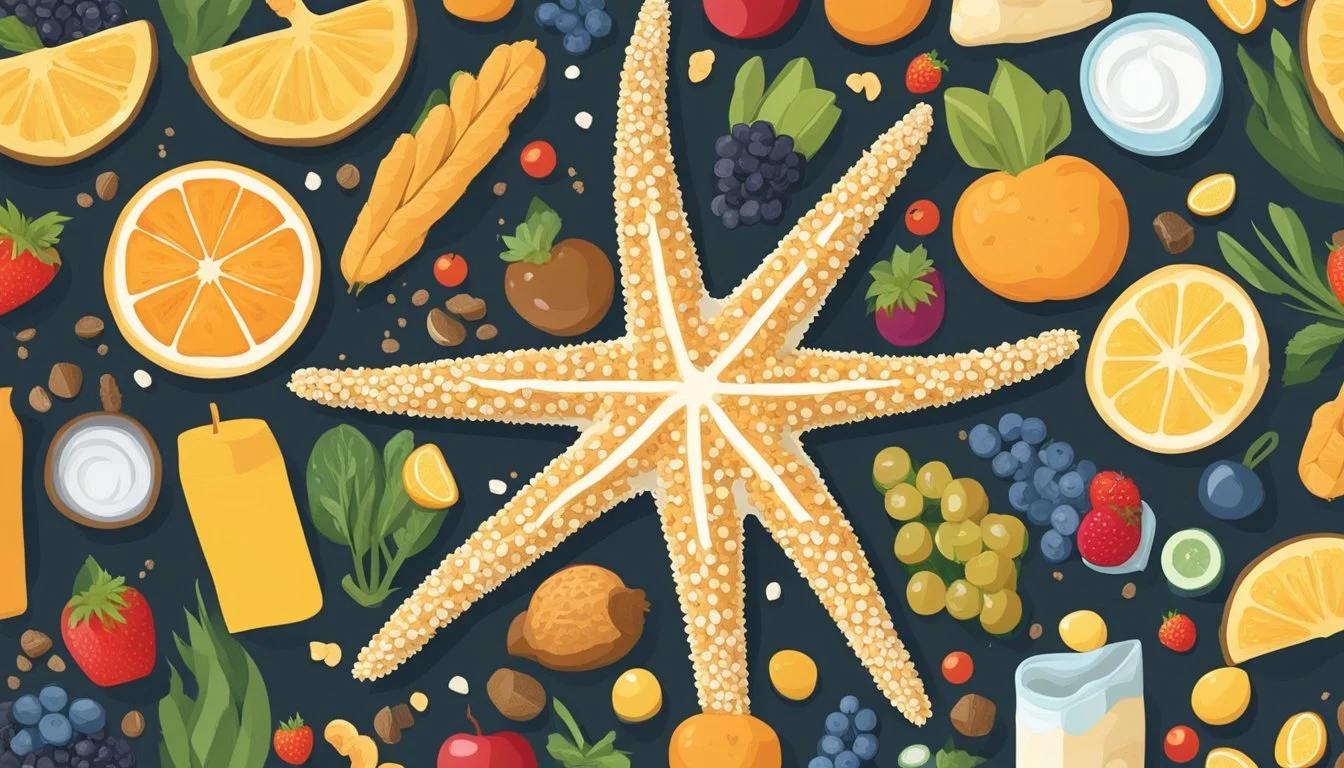Can Diabetics Eat Sea Stars?
Nutritional Insights Explained
Can diabetics eat sea stars?
Those managing diabetes often seek unique dietary options, including various forms of seafood, to benefit their health. Sea stars, however, are not commonly consumed nor recommended for a diabetic diet. Sea stars are primarily known for their role in marine ecosystems rather than as a culinary delicacy.
Seafood, in general, offers numerous health benefits for diabetics, including high protein and healthy fats. Fish like salmon, cod, and trout are rich in omega-3 fatty acids, which can improve insulin sensitivity and glucose metabolism. These qualities make traditional seafood choices more beneficial and practical for managing diabetes compared to unorthodox options like sea stars.
Including the right seafood in a diabetic diet can help control blood sugar levels while providing essential nutrients. While sea stars might intrigue the adventurous eater, it is safer and more effective to stick with proven, healthful seafood options.
Understanding Diabetes and Dietary Needs
Managing diabetes effectively involves careful dietary choices, focusing on foods that help regulate blood sugar levels and support insulin function. Specific nutrients, such as carbohydrates and omega-3 fatty acids, play vital roles.
The Role of Diet in Managing Diabetes
Diet is crucial in managing diabetes, impacting blood sugar levels directly. For instance, choosing foods with a low glycemic index can help keep blood sugar levels stable. Lean proteins and healthy fats are beneficial as they do not cause significant spikes in blood sugar.
People with diabetes should prioritize foods that provide steady energy release. Incorporating vegetables, whole grains, and lean protein into meals can help. Proper portion control is also essential to avoid blood sugar fluctuations.
Carbohydrates and Blood Sugar Regulation
Carbohydrates significantly affect blood sugar levels. They are broken down into glucose, leading to increased blood sugar. Managing carbohydrate intake is important to maintain stable blood sugar levels. Foods high in fiber, such as whole grains, have a lower glycemic index, which is beneficial.
Patients should monitor their carbohydrate intake by reading food labels and using carbohydrate counting methods. Complex carbohydrates like brown rice, quinoa, and whole oats are preferable over simple sugars. Balancing carbohydrate intake with physical activity and medication helps maintain optimal blood sugar levels.
Importance of Omega-3 Fatty Acids for Diabetics
Omega-3 fatty acids play a significant role in the diet of those with diabetes. These healthy fats, found in fish like salmon, sardines, and trout, improve insulin sensitivity and support heart health. Given that people with diabetes have a higher risk of heart disease, incorporating omega-3-rich foods is beneficial.
Fish: Salmon, mackerel, sardines
Plant-based: Flaxseeds, chia seeds, walnuts
These fats help lower inflammation and improve blood lipid profiles, contributing to better overall diabetes management. Regular consumption of omega-3s is recommended as part of a balanced diet to support metabolic health.
Nutritional Profile of Sea Stars
Sea stars may be an exotic delicacy, but understanding their nutritional components is essential for dietary considerations. Particularly, analyzing their protein, fat, and caloric content is vital.
Protein Content in Sea Stars
Sea stars are relatively low in protein compared to more conventional seafood like fish or shellfish. While they do provide some protein, the amount is not significant enough to be a primary protein source. On average, the protein content in a serving of sea star is around 10 grams, which is less than the protein found in a similar serving size of fish.
Despite the low protein content, the quality of protein in sea stars is worth noting. They contain essential amino acids that are vital for tissue repair and enzyme production. This can make them a supplementary protein option for those seeking to diversify their nutrient sources.
Fat Composition in Sea Stars
Sea stars are not considered a high-fat food. They contain minimal amounts of fat, which is predominantly unsaturated. Unsaturated fats are beneficial as they can help in reducing bad cholesterol levels, thus supporting heart health. The total fat content in a typical serving might be around 2 grams, making it a low-fat option.
The types of fats found include omega-3 fatty acids, which are known for their anti-inflammatory properties and benefits to cardiovascular health. This composition can make sea stars a unique addition to a diet, though not a primary source of dietary fats.
Caloric Value of Sea Stars
Sea stars have a low caloric value, making them suitable for a diet aiming at calorie restriction. A typical serving provides approximately 50 calories. This low caloric content is mainly due to the minimal fat and moderate protein content.
Given their low caloric value, sea stars can be included in meals without significantly impacting overall daily calorie intake. This makes them a good option for those looking to maintain or lose weight while still exploring diverse food options.
In summary, while sea stars offer modest nutritional benefits, they should be considered an occasional delicacy rather than a staple food source.
Benefits of Seafood in a Diabetic Diet
Seafood offers numerous benefits for individuals managing diabetes, providing essential nutrients without intensifying blood sugar levels.
Incorporating Fish into a Diabetes Diet
Fish like salmon, tuna, and sardines are excellent choices due to their high omega-3 fatty acid content. Omega-3s (particularly EPA and DHA) found in fatty fish help reduce inflammation and improve heart health. These fish are also low in carbs and rich in lean protein, making blood sugar management easier.
Cod and tilapia are low-calorie, high-protein options that have minimal saturated fat. Their nutritional profiles make them suitable for routine consumption. According to the American Diabetes Association, these fish can be part of a heart-healthy diet.
Comparison of Sea Stars with Common Seafood
Sea stars, or starfish, are not typically consumed in most diets due to their tough texture and low nutritional value compared to other seafood. Commonly consumed seafood such as shrimp, shellfish, and various fish species provide significantly higher benefits.
Shrimp and shellfish are low in calories and carbs while being high in protein. They also contain beneficial minerals such as zinc and selenium. Sea stars, on the other hand, lack significant levels of omega-3 fatty acids and lean protein that are crucial for managing diabetes.
Heart Health and Seafood Consumption
Consuming seafood regularly can support heart health, an essential aspect for diabetics who are at higher risk for cardiovascular disease. The American Heart Association recommends consuming fish, particularly those high in omega-3 fatty acids, at least twice a week.
EPA and DHA reduce triglyceride levels, lower blood pressure, and may reduce the risk of heart disease. Including salmon, mackerel, and sardines in a diet can effectively improve cardiovascular health outcomes for diabetics.
To conclude, incorporating a variety of nutritious seafood, such as fish with high omega-3s and lean proteins, can offer substantial health benefits for individuals managing diabetes, particularly when considering heart health and overall nutrient content.
Risks and Considerations for Diabetics Consuming Sea Stars
Diabetics need to be cautious when adding sea stars to their diets due to potential health risks and ethical considerations. Key points include possible toxin exposure, allergic reactions, and the sustainability of harvesting these marine creatures.
Potential Toxins and Mercury Content
Sea stars may contain toxins that can pose a health risk, particularly for individuals with diabetes who already have compromised metabolisms. Mercuric compounds can bioaccumulate in sea stars, leading to mercury exposure, which can be harmful. Mercury can negatively affect liver and kidney functions, critical areas for those managing diabetes.
Regular consumption of high-mercury foods can also increase triglycerides and LDL cholesterol, further complicating blood sugar management. This increases the risk of cardiovascular diseases, which diabetics are already more prone to.
Allergic Reactions and Individual Tolerances
Allergic reactions to sea stars are rare but possible. Diabetics should be aware of this due to potential complications from inflammation, which affects insulin sensitivity. Even mild allergic reactions can worsen existing conditions by triggering inflammatory responses.
Each individual may have different tolerances to new foods. For diabetics, this means careful monitoring of blood sugar levels after consuming unfamiliar items like sea stars. Consuming sea stars without consulting with healthcare providers may lead to unexpected health challenges.
Sustainability and Ethical Concerns
Harvesting sea stars can significantly impact marine ecosystems. They play a crucial role in maintaining the balance of oceanic environments. Overharvesting them affects biodiversity and the health of coral reefs and other marine habitats.
Given the ethical implications, it is important for diabetics to consider sustainable seafood options. These alternatives often have better-established safety profiles regarding toxins, allergens, and nutritional content, making them safer choices. Sustainable practices also support long-term environmental health, which aligns with broader health and ethical considerations.
Incorporating any new food into a diabetic diet requires careful thought and consultation. The risks associated with sea stars, paired with ethical issues surrounding their consumption, suggest that other, safer seafood choices might be more suitable.
Preparing Sea Stars for Diabetic Diets
When preparing sea stars for a diabetic-friendly diet, it is essential to focus on safe handling and cooking techniques, healthy cooking methods and recipes, and proper portion control and frequency of consumption.
Safe Handling and Cooking Techniques
Handling sea stars properly is crucial. Begin by thoroughly cleaning the sea stars with cold water to remove any debris or contaminants. Use a clean cutting board and knife to avoid cross-contamination with other foods.
Cooking sea stars requires specific methods to ensure they are safe to eat. Boiling or poaching in water with lemon and herbs can preserve their delicate texture while ensuring they are cooked through. Avoid high-fat or high-calorie cooking methods like deep-frying, which are unsuitable for a diabetic diet.
Healthy Cooking Methods and Recipes
Grilling: Marinade sea stars in a mixture of olive oil, lemon juice, and garlic. Grill them over medium heat until they are tender. This low-calorie method adds flavor without unnecessary fats.
Baking: Place sea stars on a baking sheet with a drizzle of olive oil and your favorite herbs. Bake at 375°F until cooked through. Baking retains nutrients while providing a healthier alternative to frying.
Soup: Add chunks of sea star to a vegetable-rich broth. Simmer with spices like ginger and garlic, which can help manage blood sugar levels. Opt for a clear broth to keep it low-fat and low-calorie.
Portion Control and Frequency of Consumption
For people with diabetes, moderation is key. Limit portions of sea star to about 3-4 ounces per serving. This helps control calorie and carbohydrate intake, which is crucial for managing blood sugar levels.
Eating sea stars once or twice a week is sufficient. Incorporate them into meals such as soup or tacos for variety. Balancing sea stars with other low-fat and high-protein ingredients ensures a well-rounded, diabetic-friendly diet.
Keep track of portion sizes and monitor blood sugar levels to adjust the frequency of consumption based on individual needs.
Alternative Sources of Nutrients for Diabetics
People with diabetes can benefit from various nutrient-rich alternatives, ensuring their dietary needs are met while managing their condition. Options include plant-based foods high in omega-3 fatty acids, lean meats and poultry with low fat, and legumes, nuts, and seeds packed with essential nutrients.
Plant-Based Alternatives Rich in Omega-3s
Plant-based sources such as flaxseed oil, chia seeds, and walnuts are excellent for omega-3 fatty acids.
Chia seeds and flaxseed oil can be easily incorporated into diet through smoothies or salads. Walnuts can be a great addition to meals or snacks, providing both omega-3s and protein. Tofu and avocado also offer healthy fats, making them valuable replacements for more traditional sources of omega-3s like fish.
Lean Meats and Poultry as Substitutes
Lean meats and poultry provide high-quality protein while being low in unhealthy fats. Turkey and skinless chicken breast are prime choices.
They are versatile; turkey can be used in sandwiches, and chicken can be roasted or grilled. When cooking, using olive oil instead of butter can reduce unhealthy fat intake. These meats help maintain stable blood sugar levels, essential for diabetics.
Incorporating Nuts, Seeds, and Legumes
Beans, seeds, and nuts such as almonds and peanuts are excellent sources of protein, fiber, and healthy fats.
Beans, including black and kidney beans, can be used in soups or salads. Nuts and seeds can be eaten on their own or added to yogurt and cereal. Regular consumption supports sustained energy levels and aids in glucose management. Moreover, they are convenient, healthy snack options that fit into a balanced diet.








